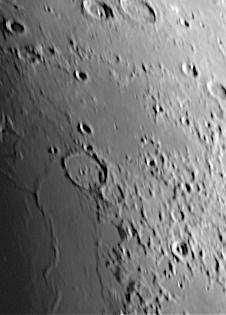Observing the Moon: The Eastern Shore of Serenity
Jack Kramer
When the moon is about six days old, the eastern edge of Mare Serenitatis -- the "Sea of Serenity" -- stands in bold relief on the terminator. At this time, the eroded crater Posidonius is prominent. This crater was described by one observer as a "light, eliptical pancake on the dark mare plain" because of its immediate appearance as a large, smooth, somewhat raised circle. That observer was probably using binoculars or a very small telescope, because close investigation shows a wealth of detail on the floor of Posidonius. The almost-central craterlet stands out especially well.

Immediately to the west, you can see the beginnings of the Serpentine Ridge which runs due south in Mare Serenitatis. This ridge is only about seven miles wide, but meanders for quite a long distance. Ridges appear in the lunar plains and may be the result of a shifting of the surface after the lava solidified. They are fairly low in height, so they need a low angle of sunlight to be seen well. The Serpentine Ridge is one of the few that have actually been named. Hugging the bottom border of the image here is the crater Littrow, near which the Apollo 17 lunar module landed on December 11, 1972.
Published in the March 1998 issue of the NightTimes




